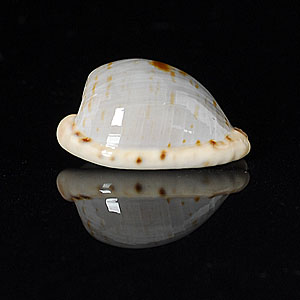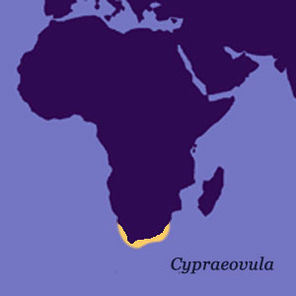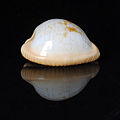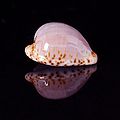Cypraeovula
| Cypraeovula | ||||||||||||
|---|---|---|---|---|---|---|---|---|---|---|---|---|

Cowrie shell |
||||||||||||
| Systematics | ||||||||||||
|
||||||||||||
| Scientific name | ||||||||||||
| Cypraeovula | ||||||||||||
| Gray , 1824 |
Cypraeovula , also known internationally as "bubble cowries", is a genus from the family of cowries (Cypraeidae). The species of this genus occur exclusively on the southern coasts of Africa.
features
The typical sizes vary between 18 mm ( C. edentula ) and 38 mm ( C. fuscodentata ). The papillae are short and wart-shaped. The shells of the deeper species are mostly spherical, those of the other species are somewhat more elongated. The striking curvature of the case is striking - hence the name "Bubble-cowries". The other features, such as the mantle , the radula or the shape of the housing teeth, diverge strongly. Even within a species, the callus can be clearly visibly different.
Systematics
The genus Cypraeovula was established by John Edward Gray in 1824. Type species is Cypraeovula capensis Gray, 1824. The marine biologists Felix Lorenz and Alex Hubert divided this genus into two groups. On the one hand in the "Crossia group" introduced by Shikama (as a subgenus) and on the other hand in the "Algoensis group".
The " Crossia-group ", the common features of the particular depth of the living space, the spherical housing and, more clearly than in the "Algoensis group" formed, fossula are composed of the following species: cruickshanki , Connelli , iutsui . These typically occur at a depth of 100 m or more. One can only guess to what depth these species live. There are indications that cruickshanki can also be found at a depth of 650 m. This assumption and the documented depths of the other “deep-sea cypraeovula” are based on information from the fishery. Shells of the aforementioned species can sometimes be found in the nets of deep-sea fishermen, and live finds are extremely rare. In the “ Algoensis group ” the authors listed all other species.
After recent studies have shown that this dichotomy of the genus does not do justice to the circumstances, Lorenz (September 2006) suggests dividing Cypraeovula as follows:
" Luponia group ": capensis , edentula , algoensis , mikeharti , alfredensis , fuscodentata , fuscorubra , coronata
" Crossia group ": castanea , iutsui , volvens
" Cruickshanki group ": cruickshanki , connelli
Intermediate forms : colligata , kesslerorum
At this point it must be pointed out that the previously listed systematics need not be viewed in this way by all taxonomists. Opinions naturally diverge, especially when it comes to this strongly diverging and rarely occurring genus.
species
- Cypraeovula alfredensis Schilder & Schilder, 1929
- Cypraeovula algoensis Gray, 1825
- Cypraeovula capensis Gray, 1828
- Cypraeovula castanea Higgins, 1868
- Cypraeovula colligata Lorenz, 2002
- Cypraeovula connelli Liltved, 1983
- Cypraeovula coronata shield, 1930
- Cypraeovula cruickshanki Kilburn, 1972
- Cypraeovula edentula Gray, 1825
- Cypraeovula fuscodentata Gray, 1825
- Cypraeovula fuscorubra Shaw, 1909
- Cypraeovula immelmani Liltved, 2001
- Cypraeovula iutsui Shikama, 1974
- Cypraeovula kesslerorum Lorenz, 2006
- Cypraeovula mikeharti Lorenz, 1985
- Cypraeovula volvens Fazzini & Bergonzoni, 2004
photos
Individual evidence
- ↑ Bubble-cowries, A Review of the cruickshanki-group Archive link ( Memento of the original from July 23, 2008 in the Internet Archive ) Info: The archive link was automatically inserted and has not yet been checked. Please check the original and archive link according to the instructions and then remove this notice.
literature
- A Guide To Worldwide Cowries , Felix Lorenz & Alex Hubert, 2000. ISBN 3-925919-25-2






